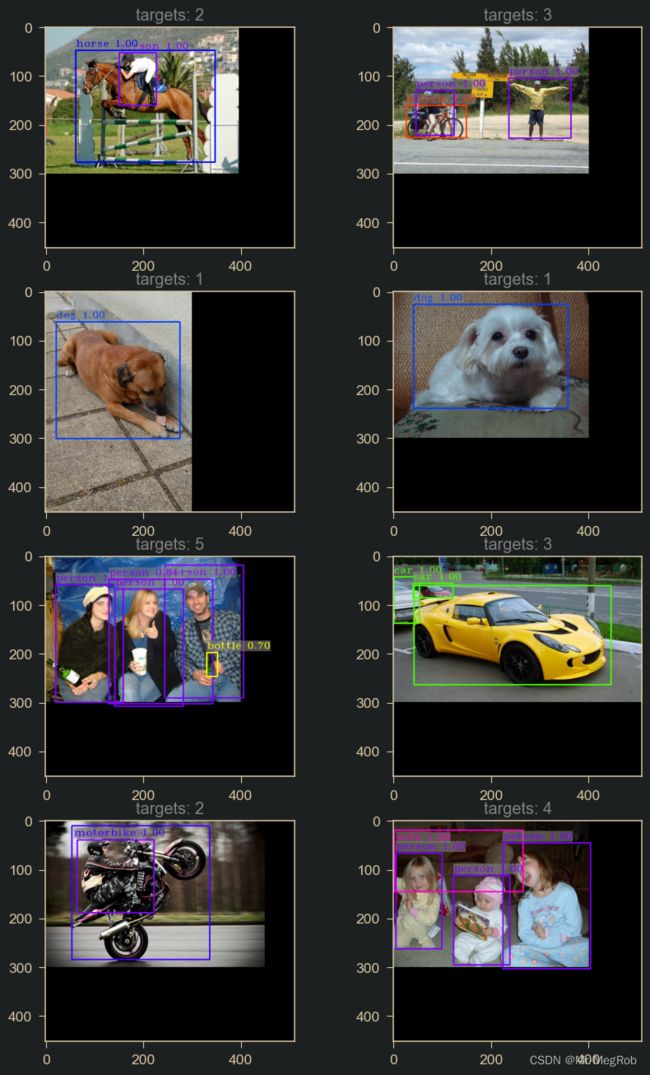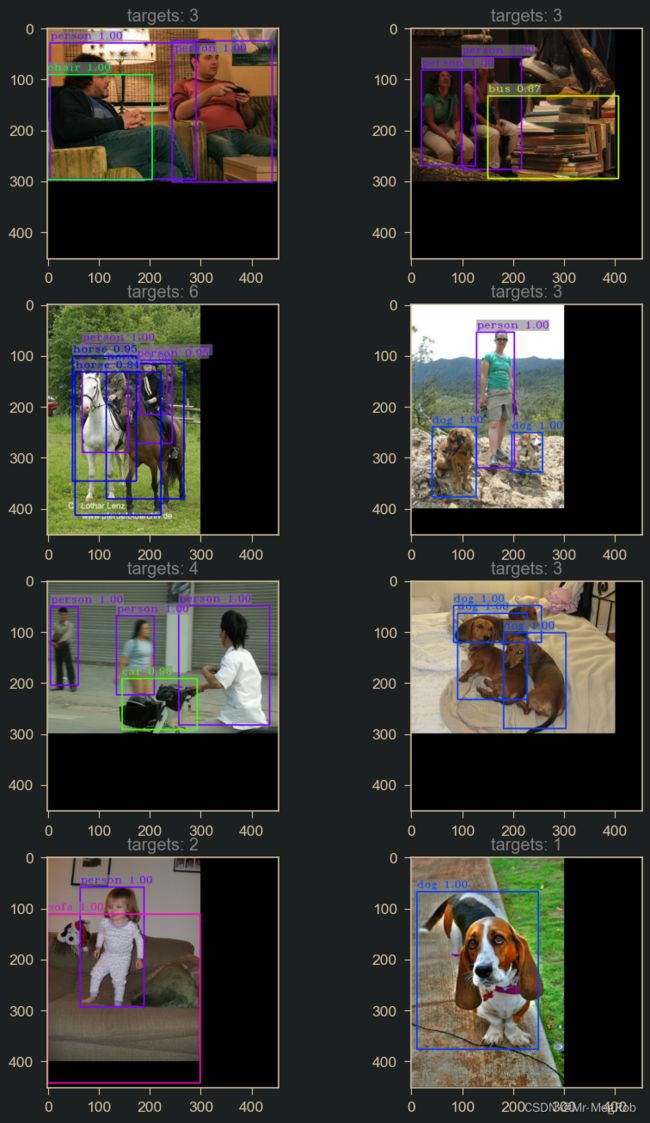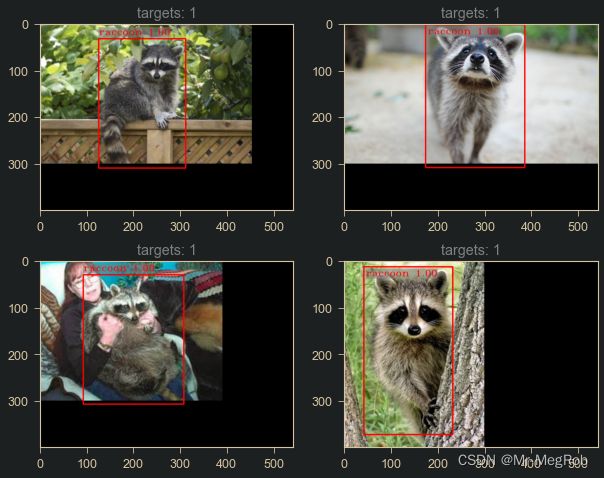保姆级 Keras 实现 Faster R-CNN 十四 (预测)
保姆级 Keras 实现 Faster R-CNN 十四
- 一. 预测模型
- 二. TargetLayer
- 三. 预测
- 四. 显示预测结果
- 五. 加载训练好的参数
- 六. 效果展示
- 七. 代码下载
上一篇 文章中我们完成了 Faster R-CNN 训练的功能, 现在到了预测部分了
一. 预测模型
因为在预测的时候并不需标签, 所以 RoiLabelLayer 就不需要了, 也不需要将标签与 rcnn_cls, rcnn_reg 组合. 模型变得更简单了. 以下是用于预测的模型, 相对的是 上一篇 文章中的训练模型
# 创建预测模型
# iou_thres: 做 NMS 时 IoU 阈值
def create_predict_model(self, iou_thres = 0.6, summary = True):
x_image = keras.layers.Input(shape = (None, None, 3), name = "input")
features = self.base_net(x_image)
rpn_cls, rpn_reg = self.rpn_net(features)
proposals = ProposalLayer(self.base_anchors,
stride = self.feature_stride,
num_rois = self.train_num,
iou_thres = self.nms_thres,
name = "proposal")([x_image, rpn_cls, rpn_reg])
pooled_rois = RoiPoolingLayer(name = "roi_pooling")([x_image, features, proposals])
rcnn_cls, rcnn_reg = self.fast_rcnn(pooled_rois,
cells = self.dense_cells,
num_classes = self.NUM_CLS)
targets = TargetLayer(iou_thres = iou_thres,
name = "targets")([x_image, proposals, rcnn_reg, rcnn_cls])
self.model = keras.Model(inputs = x_image,
outputs = targets,
name = "faster_rcnn")
if summary:
self.model.summary()
二. TargetLayer
在上面的模型中, 我们在后面接了一个 TargetLayer, 有了它可以将模型输出变成我们想要的三个值, 分别是 预测框坐标, 类别与分数, 模型用起来更方便, TargetLayer 代码如下
# 定义 Target Layer
class TargetLayer(Layer):
# iou_thres: 做 NMS 时 IoU 阈值
def __init__(self, iou_thres = 0.6, **kwargs):
self.iou_thres = iou_thres
self.ANCHOR_DIMS = 4
super(TargetLayer, self).__init__(**kwargs)
def build(self, input_shape):
self.targets = input_shape[1][1] # NMS 后剩下的目标数量, 最多为建议框的数量
super(TargetLayer, self).build(input_shape)
def call(self, inputs):
# inputs 是一个列表, 可以拆分为下面的参数
# image: 输入的原始图像
# boxes: 建议框
# deltas: 修正值
# scores: 类别分数
image, boxes, deltas, scores = inputs
batch_size = tf.shape(image)[0]
image_shape = tf.shape(image)[1: 3]
# 类别序号
class_id = tf.argmax(scores, axis = -1)
# 最大类别分数
scores = tf.reduce_max(scores, axis = -1)
# 将序号为 0 对应的分数变成 0, 因为是背景, 判断为背景的分数自然就高, NMS 会有问题
mask = tf.cast(class_id > 0, dtype = tf.float32)
scores *= mask
# 修正建议框
boxes = self.apply_box_deltas(image_shape, boxes, deltas)
# 拆分与组合操作
selected_boxes, selected_ids, selected_scores = tf.map_fn(
lambda i: self.batch_process(image_shape,
tf.reshape(boxes, (batch_size, -1, self.ANCHOR_DIMS)),
tf.reshape(scores, (batch_size, -1)),
tf.reshape(class_id, (batch_size, -1)),
i),
tf.range(batch_size, dtype = tf.int32),
dtype = (tf.float32, tf.int64, tf.float32),
back_prop = False)
boxes = tf.reshape(selected_boxes, (batch_size, -1, self.ANCHOR_DIMS))
class_id = tf.reshape(selected_ids, (batch_size, -1, 1))
scores = tf.reshape(selected_scores, (batch_size, -1, 1))
return [boxes, class_id, scores]
def compute_output_shape(self, input_shape):
return [(input_shape[1][0], self.targets, input_shape[1][2]),
(input_shape[3][0], self.targets, 1),
(input_shape[3][0], self.targets, 1)]
# 修正建议框
def apply_box_deltas(self, image_shape, boxes, deltas):
# 宽度和高度
w = boxes[..., 3] - boxes[..., 1]
h = boxes[..., 2] - boxes[..., 0]
# 中心坐标
x = boxes[..., 1] + w * 0.5
y = boxes[..., 0] + h * 0.5
# 修正 anchor_box
x += deltas[..., 0] * w
y += deltas[..., 1] * h
w *= tf.exp(deltas[..., 2])
h *= tf.exp(deltas[..., 3])
# 转换成 y1, x1, y2, x2 格式
x1 = x - w * 0.5
y1 = y - h * 0.5
x2 = x + w * 0.5
y2 = y + h * 0.5
# 不管是训练还是预测, 超出范围的框分数也可能比较大, 所以都截断保留
x1 = tf.maximum(x1, 0)
y1 = tf.maximum(y1, 0)
x2 = tf.minimum(x2, tf.cast(image_shape[1], dtype = tf.float32))
y2 = tf.minimum(y2, tf.cast(image_shape[0], dtype = tf.float32))
# 如果用 tf.image.non_max_suppression 的话, 要按 y1, x1, y2, x2 的格式
boxes = tf.stack([y1, x1, y2, x2], axis = -1)
return boxes
# 数据填充
# pad_num: 填充数量
def data_pad(self, boxes, class_ids, scores, pad_num):
padd_boxes = tf.zeros((pad_num, 4), dtype = tf.float32)
padd_ids = tf.zeros((pad_num, ), dtype = tf.int64)
padd_scores = tf.zeros((pad_num, ), dtype = tf.float32)
boxes = tf.concat((boxes, padd_boxes), axis = 0)
class_ids = tf.concat((class_ids, padd_ids), axis = 0)
scores = tf.concat((scores, padd_scores), axis = 0)
return boxes, class_ids, scores
# 处理 batch 内一个数据
# boxes: 修正后的建议区域矩形
# scores: 建议框矩形对应的分数
# i: batch 内第几个数据
def batch_process(self, image_shape, boxes, scores, class_ids, i):
selected_indices = tf.image.non_max_suppression(boxes[i], scores[i],
self.targets, self.iou_thres)
selected_boxes = tf.gather(boxes[i], selected_indices)
selected_ids = tf.gather(class_ids[i], selected_indices)
selected_scores = tf.gather(scores[i], selected_indices)
num_selected_boxes = tf.shape(selected_boxes)[0]
pad_num = self.targets - num_selected_boxes
selected_boxes, selected_ids, selected_scores = tf.cond(
num_selected_boxes < self.targets,
lambda: self.data_pad(selected_boxes, selected_ids, selected_scores, pad_num),
lambda: (selected_boxes, selected_ids, selected_scores))
return selected_boxes, selected_ids, selected_scores
代码也不复杂, 和 ProposalLayer 有点像, 可以对比着看
三. 预测
有了完成的模型, 我们就可以预测了, 也定义一个函数方便调用
# 预测
# x: 生成器或图像路径
def predict(self, x):
# 如果是图像路径, 那要将图像预处理成网络输入格式
# 如果不是则是 input_reader 返回的图像, 已经满足输入格式
if isinstance(x, str):
img_src = cv.imread(x)
img_new, scale = self.new_size_image(img_src)
x = [img_new]
x = np.array(x).astype(np.float32) / 255.0
else:
(x, _, __), y = next(x)
return x, self.model.predict(x)
预测的时候, 参数可以是一个生成器或图像的路径, 用图像路径作为参数时, 一次只能预测一张图像
返回值是预测图像, 坐标值, 类别, 分数
四. 显示预测结果
有了预测结果, 我们需要将预测的结果标记到图像上
# 显示预测结果
# x: 生成器或图像路径
# show_proposals: 如果 show_proposals > 0, 只显示 show_proposals 个建议框, 否则显示预测结果
# color_list: 显示颜色表
# show_cols: 显示列数
def show_predict(self, x, show_proposals = 0, color_list = None, show_cols = 4):
image, (boxes, class_ids, scores) = self.predict(x)
print(image.shape, boxes.shape, class_ids.shape)
batch_size = image.shape[0]
image_shape = image.shape[1: 3]
show_list = []
if show_proposals > 0:
proposal_model = keras.Model(inputs = self.model.input,
outputs = self.model.get_layer("proposal").output)
proposals = proposal_model.predict(image)
print(proposals.shape)
for i in range(batch_size):
img_show = image[i].copy()
for j, box in enumerate(proposals[i]):
if j >= show_proposals: # 显示建议框的数量
break
# 预测的 box 的坐标顺序是 (y1, x1, y2, x2), 显示的时候变成(x1, y1, x2, y2)
cv.rectangle(img_show, (int(box[1]), int(box[0])), (int(box[3]), int(box[2])),
(random.random(), random.random(), random.random()), 2)
show_list.append((img_show, show_proposals))
else:
# 显示颜色
if None == color_list:
color_list = []
for i in range(self.NUM_CLS):
color_list.append((random.random(), random.random(), random.random()))
for i in range(batch_size):
targets = 0
img_show = image[i].copy()
for j, box in enumerate(boxes[i]):
idx = int(class_ids[i][j])
score = scores[i][j]
if idx > 0:
targets += 1
# 预测的 box 的坐标顺序是 (y1, x1, y2, x2), 显示的时候变成(x1, y1, x2, y2)
cv.rectangle(img_show, (int(box[1]), int(box[0])), (int(box[3]), int(box[2])),
color_list[idx], 2)
text_x, text_y = int(box[1]), int(box[0])
if text_y <= 24:
text_x += 4
text_y += 20
else:
text_y -= 8
text = self.categories[idx] + " {0:.2f}".format(float(score))
font = cv.FONT_HERSHEY_COMPLEX_SMALL
(w, h), _ = cv.getTextSize(text, font, 1, 1)
if text_x + w > image_shape[1]:
text_x = image_shape[1] - w
text_background = np.ones((h + 8, w, 3), np.float32) * 0.5
img_show[text_y - h - 2: text_y + 6, text_x: text_x + w] = cv.addWeighted(
img_show[text_y - h - 2: text_y + 6, text_x: text_x + w], 0.4,
text_background, 0.6, 0)
cv.putText(img_show, text, (text_x, text_y),
font, 1, color_list[idx], 1, cv.LINE_AA)
show_list.append((img_show, targets))
figsize = (min(12, max(10, show_cols * 4)), max(6, batch_size // show_cols * 4))
plt.figure("predict_images", figsize = figsize)
show_rows = max(1, batch_size // show_cols + (1 if batch_size % show_cols else 0))
for i, (img_show, t) in enumerate(show_list):
if batch_size > 1:
plt.subplot(show_rows, show_cols, i + 1)
plt.title("targets: " + str(t), color = 'gray')
plt.imshow(img_show[..., : : -1])
plt.show()
show_proposals 参数需要提一下, 这个参数是用来控制显示建议框的, 当 show_proposals > 0 时, 只显示指定数量的建议框, 方便查看建议框的效果
五. 加载训练好的参数
预测模型需要加载训练好的参数, 代码如下
# 加载模型与参数
# file_name: 保存的文件名称
# load_model: 是否要加载模型
# load_weight: 是否加载存参数
def load(self, file_name, load_model = False, load_weight = True):
if load_model or (True == load_weight and None == self.model):
self.model = load_model(osp.join(self.log_path, file_name + "_model.h5"))
if load_weight:
self.model.load_weights(osp.join(self.log_path, file_name + "_weights.h5"), True)
六. 效果展示
需要预测的时候, 我们只需如下操作即可
# 如果要检测的目标数比较少, 预测时可以把 train_num 改小一点
# faster_rcnn.train_num = 64
faster_rcnn.create_predict_model(iou_thres = 0.6, summary = False)
faster_rcnn.load("faster_rcnn", False, True)
# 测试集
test_reader = faster_rcnn.input_reader(faster_rcnn.test_set, batch_size = 4, train_mode = False)
# 显示预测结果
# show_proposals > 0 时, 只显示建议框
faster_rcnn.show_predict(test_reader, show_proposals = 0, color_list = BGR_COLOR, show_cols = 2)
# test_reader 也可以直接给图像的路径, 比如
# faster_rcnn.show_predict(r"test_set\00001.jpg", show_proposals = 0, color_list = BGR_COLOR, show_cols = 2)
以下是 VOC2007 训练集的测试效果, 短边设置为 300, 图像中有黑边是为了同一 batch 中的图有相同的尺寸而做了填充
测试集的效果
以下是小浣熊的预测效果
训练集数据
从网上下载的图像测试
在前面的文章中用的数据集是 VOC2007, 为了训练快一点, 我们做的数据增强也只有简单的翻转图像. 对于 VOC2007, 这样训练出来的模型在测试集上效果会差一点. 解决这个问题最简单粗暴的方式就是增加训练数据量. 最简单的增加数据量的方法就是做数据增强. 所以我们可以在 data_augment 函数中增加一些 旋转, 缩放, 裁切, 变形, 改变亮度, 改变色温 之类的增强. 这里就不演示了. 只是要注意的是标签要做相应的变化, train 函数的参数 augmented_num 也要修改成对应的值
小浣熊的预测貌似效果还可以, 是因为我挑了一些和训练集比较相似的图像, 如果预测其他背景或者毛色差异比较大的图像, 效果就差很多. 主要是训练的图像只有两百张. 多一点的话, 效果也会好一点
到这里, 《保姆级 Keras 实现 Faster R-CNN》系列文章就结束了
七. 代码下载
示例代码可下载 Jupyter Notebook 示例代码
上一篇: 保姆级 Keras 实现 Faster R-CNN 十三 (训练)



